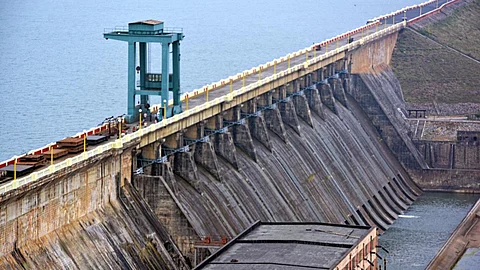
- Topics
- Feature
- Opportunities & Events
- Data
- Hindi Portal
- Topics
- Feature
- Opportunities & Events
- Data
- Hindi Portal

Reservoir sedimentation is often seen as a site-specific process and is usually assessed at an individual reservoir level. At the same time, it takes place everywhere in the world. However, estimates of storage losses globally are largely lacking. A recent study by the UN University's Institute for Water, Environment and Health warned that trapped sediment has already robbed roughly 50,000 large dams worldwide of an estimated 13-19% of their combined original storage capacity.
In this study, the University applied previously-determined storage loss rates in various areas worldwide to 47,403 large dams in 150 countries to forecast cumulative reservoir storage losses by country, region, and globally. These losses are estimated for the time horizons of 2022, 2030, and 2050.
Researchers noted that the reservoir sedimentation rates and associated storage losses are site-specific and vary significantly between regions. As per the study, 16% of the original capacity had already been lost. It said the United States is facing losses of 34% by 2050, with Brazil estimated to lose 23%, and China about 20% of its original capacity.
It is shown that 6316 billion m3 of initial global storage in these dams will decline to 4665 billion m3 causing a 26% storage loss by 2050. When it comes to Europe, the 6,651 large dams across 42 European countries had a total initial storage capacity of 895 billion cubic meters. The region has already lost 19% of that volume, and will lose up to 21% by 2030 and 28% by 2050, the study found.
Asia-Pacific and African regions will likely experience relatively smaller storage losses in the next 25+ years compared to the Americas or Europe. On a country level, Seychelles, Japan, Ireland, Panama, and the United Kingdom will experience the highest water storage losses by 2050, ranging between 35% and 50%. In contrast, Bhutan, Cambodia, Ethiopia, Guinea, and Niger will be the five least affected countries losing less than 15% of storage by 2050.
The decrease in the available storage by 2050 in all countries and regions will challenge many aspects of national economies, including irrigation, power generation, and water supply. The newly built dams will not be able to offset storage losses to sedimentation.
The paper titled ‘Present and Future Losses of Storage in Large Reservoirs Due to Sedimentation: A Country-Wise Global Assessment’ published in Sustainability is an alert to this creeping global water challenge with potentially significant development implications. It attempts to estimate a global variation of storage losses of large dams due to sedimentation in much more detail. While it utilizes the storage loss rates suggested by Wisser et al., they are applied in this study to the much larger and most comprehensive global dataset of large dams available at present—that of the International Commission on Large Dams (ICOLD).
Additionally, the study makes estimates of storage losses by country and ranks countries by the magnitude of their storage losses to sedimentation. A country-wise approach is essential, as the problems of reservoir sedimentation and overall future water storage development are dealt with by each nation individually. This examines the relative urgency of addressing the issue of storage losses in different countries and regions of the world.
It is shown that the regionwide storage loss percentages for 2022 range between major regions between 13% and 19%; for 2030, between 16% and 21%; and for 2050, between 23% and 28%. Globally, storage losses by now have reached 16% of the initial storage capacity. By 2050, storage losses are estimated to be the lowest (23%) in the Asia-Pacific region, while in the Americas and Europe, storage losses are the highest (28%). Globally, an additional 10% of storage loss will likely occur from 2022 (16%) to 2050 (26%), with averaged annual losses of 0.36% of initial global storage capacity.
Numerous innovative solutions have been developed and are applied worldwide to manage reservoir sedimentation. Dredging is one of those, but it can be costly and, eventually, only a temporary solution, with an ongoing expense. Sediment flushing is more financially attractive but may have significant adverse impacts downstream.
Solutions such as bypass (or diversion) may be seen as “near-nature” and are gaining traction due to the growing public quest to minimize dams’ adverse environmental impacts. Bypassing is a technique that diverts the flow downstream via a separate channel, often used to manage high-flow events where sediment concentration is particularly high. Bypass tunnels can achieve an efficiency of 80%–90% of all sediment at their optimum operational levels.
Enhancement of the dam height is another alternative to recover the storage loss due to sedimentation. However, this should be executed only after a careful assessment of the structural strength of the dam. The benefits of doing this are manifold: more storage for the intended dam function. However, the increase in height means that the reservoir area will also expand, potentially displacing communities and leading to certain habitat losses.
Complete removal of dams, including those that are filled with sediments, is also a (slowly) emerging practice. Dam removal can bring rivers back to their natural state and re-establish the natural river sediment transport. However, certain treatment and disposal of sediments accumulated in a reservoir may be needed as they may contain heavy metals and other toxins.
The study’s results need to be interpreted at the local level considering local specifics and factors beyond this study’s scope. However, what is important to underline is that the overall magnitude of water storage losses due to sedimentation is quite disturbing. It adds to the list of water development issues that the world is already facing and has been unable to resolve.
The full paper can be accessed here
Perera D, Williams S, Smakhtin V. Present and Future Losses of Storage in Large Reservoirs Due to Sedimentation: A Country-Wise Global Assessment. Sustainability. 2023; 15(1):219. https://doi.org/10.3390/su15010219